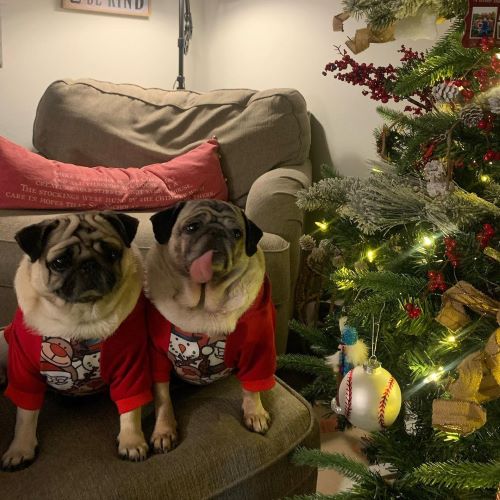How To Train A Pug Puppy – The Ultimate Guide
Pugs are known for their big personalities, comical expressions, and unwavering loyalty. However, to ensure that your adorable little companion grows up to be a well-behaved and happy dog, proper training is essential. Pug puppies have their own unique quirks and needs, so it's important to tailor your training approach to their specific requirements. In this ultimate guide, we'll walk you through everything you need to know to successfully train your Pug puppy, from house training and basic obedience to leash walking. By the end of this article, you'll be well-equipped to raise a delightful, well-mannered Pug that will bring joy to your life for years to come.
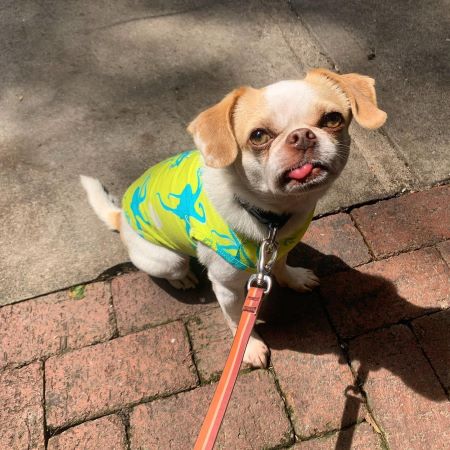
What Makes Pug Puppies Unique?
Pugs are known for their distinctive characteristics and needs that set them apart from other breeds. Here's what you should know about Pug puppies:
Temperament:
- Affectionate and playful
- Thrive on human companionship
- Intelligent and eager to please
- Can be stubborn at times
Common Health Issues:
- Respiratory problems due to their flat face and short snout
- Prone to obesity
- Eye problems, skin fold infections, and hip dysplasia
Developmental Stages:
- Birth to 8 weeks: Highly dependent on mother and littermates
- 8 to 16 weeks: Critical socialization period, ideal for starting basic training
- 4 to 6 months: Juvenile stage, may test boundaries and require consistent reinforcement
By understanding your Pug puppy's unique traits, potential health concerns, and developmental stages, you can create a tailored training approach that meets their specific needs. Keeping these factors in mind will help you raise a happy, healthy, and well-behaved Pug companion.deeper into the endearing world of cute Pugs, you will discover not just the joys of their companionship but also the rich tapestry of their social behaviors and the best ways to cater to their well-being

2. How to Prepare for Training Your Pug Puppy
Before you begin training your Pug puppy, it's essential to set up a safe and comfortable environment and gather the necessary supplies. Here's what you should do:
Create a Safe Space:
- Puppy-proof your home by removing potential hazards
- Designate a quiet area for your puppy's bed or crate
- Ensure your puppy has access to fresh water and a comfortable place to rest
Training Supplies:
- Collar and leash: Choose a lightweight, adjustable collar and a 4-6 foot leash
- Training treats: Opt for small, soft treats that are easy for your Pug puppy to chew
- Puppy pads: If you plan on using indoor potty training, have a supply of puppy pads
- Chew toys: Provide a variety of chew toys to redirect your puppy's chewing habits

Establish a Routine:
- Create a consistent schedule for feeding, potty breaks, playtime, and training sessions
- Stick to the schedule as closely as possible to help your puppy feel secure and understand expectations
- Gradually adjust the routine as your puppy grows and their needs change
By setting up a safe environment, gathering the right supplies, and establishing a consistent routine, you'll create a solid foundation for successfully training your Pug puppy. Remember, a well-prepared environment and a predictable schedule will help your puppy feel more comfortable and receptive to learning new things.
3. How to House Train Your Pug Puppy
House training is one of the first and most important things you'll need to teach your Pug puppy. Here's a step-by-step guide to help you successfully house-train your furry friend:
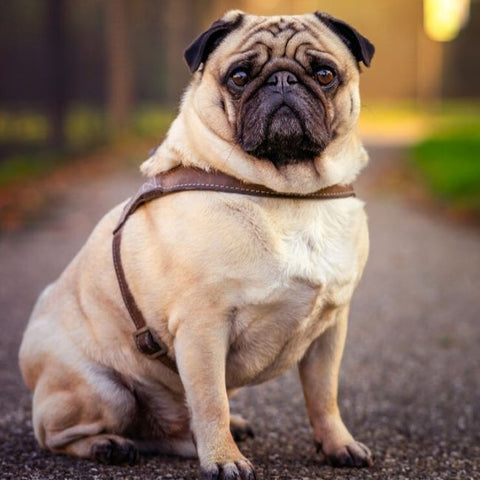
Understand Your Pug's Needs:
- Pug puppies have small bladders and will need frequent potty breaks
- They typically need to go after waking up, eating, drinking, and playing
- Watch for signs that your puppy needs to go, such as sniffing, circling, or whining
Choose a House Training Method:
- Crate training: Helps prevent accidents by using your puppy's natural instinct not to soil their sleeping area
- Puppy pad training: Ideal for apartment living or when you can't take your puppy outside frequently
- Outdoor potty training: Teaches your puppy to go potty outside from the start
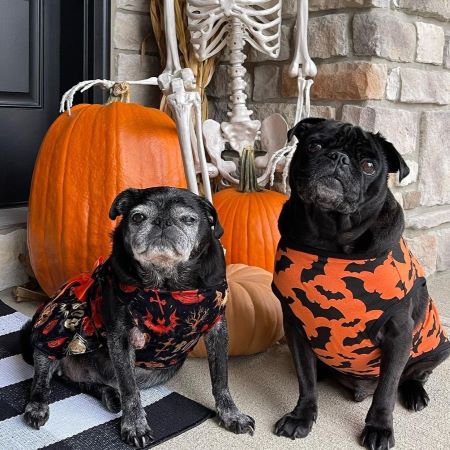
Establish a Potty Routine:
- Take your puppy to their designated potty area regularly, especially after meals and naps
- Use a specific phrase, like "go potty," to help your puppy associate the command with the action
- Reward your puppy with praise and treats immediately after they go potty in the appropriate area
Handle Accidents Positively:
- Accidents are a normal part of the learning process, so stay patient and calm
- If you catch your puppy in the act, interrupt them with a gentle "no" and take them to their potty area
- Clean up accidents thoroughly with an enzymatic cleaner to remove odors that may attract your puppy back to the same spot
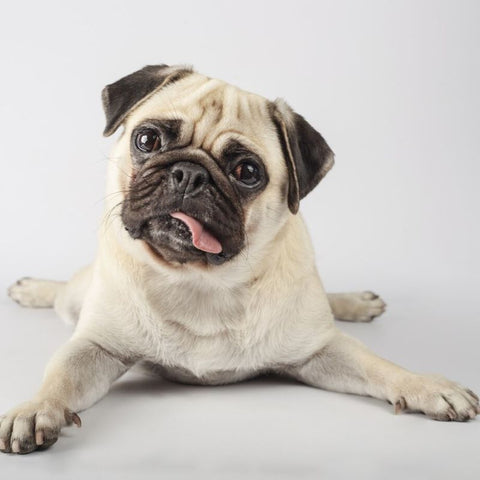
Consistency is key when house training your Pug puppy. Stick to your chosen method and routine, and celebrate your puppy's progress along the way. With patience and positive reinforcement, your Pug puppy will soon learn to go potty in the appropriate place.
4. How to Teach Your Pug Puppy Basic Obedience
Teaching your Pug puppy basic obedience is essential for a well-behaved and happy dog. Here's how you can get started:
Teach Essential Commands:
- Sit: Hold a treat close to your puppy's nose, then move it slowly over their head. As they follow the treat, their bottom should naturally go into a sitting position.
- Stay: Ask your puppy to sit, then hold your hand out in front of you and say "stay." Slowly back away, and if your puppy stays, reward them with a treat.
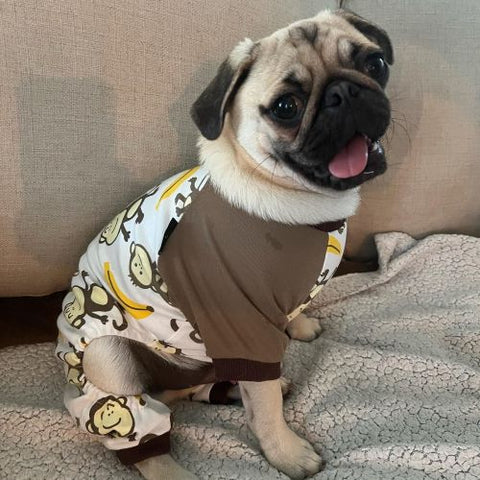
- Come: Start by calling your puppy's name followed by "come" in a happy tone. When they come to you, reward them with a treat and praise.
- Down: Ask your puppy to sit, then lower a treat to the ground in front of their paws. As they lie down to get the treat, say "down" and reward them.
- Leave it: Place a treat on the ground, and when your puppy goes to sniff it, cover it with your hand and say "leave it." When they look away, reward them with a different treat.

Use Positive Reinforcement:
- Reward your Pug puppy with treats, praise, and affection when they follow a command correctly
- Avoid punishment or scolding, as this can discourage your puppy from learning and damage your bond
Keep Training Sessions Short and Fun:
- Pug puppies have short attention spans, so aim for 5-10-minute training sessions
- Make training feel like a game, using a happy tone and plenty of rewards
- End each session on a positive note, with a command your puppy has mastered

Gradually Increase Difficulty:
- Once your puppy has mastered a command in a quiet environment, practice in different locations with more distractions
- Slowly increase the duration of commands like "stay," and the distance you move away from your puppy
- Be patient and consistent, as it may take time for your puppy to learn and respond reliably in various situations
Every puppy learns at their own pace, so don't get discouraged if progress seems slow. Celebrate your Pug puppy's successes, and keep training sessions positive and engaging. With time and practice, your Pug puppy will develop a strong foundation in basic obedience.
How to Leash Train Your Pug Puppy and Socialize Them
You should start leash training and getting your Pug puppy used to new sights and sounds when they're around 7 to 8 weeks old. Leash training and socialization are crucial aspects of raising a well-rounded and confident Pug puppy. Here's how you can successfully tackle these two important tasks:
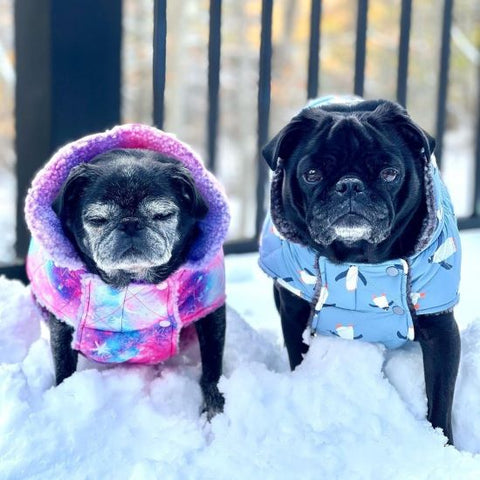
Introduce the Collar and Leash:
- Start by letting your puppy wear their collar for short periods, gradually increasing the duration
- Once your puppy is comfortable with the collar, attach the leash and let them drag it around while supervised
- Reward your puppy with treats and praise for positive interactions with the leash
Teach Loose-Leash Walking:
- Start in a low-distraction environment, like your backyard or living room
- Encourage your puppy to walk beside you by holding a treat at your side
- If your puppy pulls, stop walking and wait until they return to your side before continuing
- Reward your puppy for walking calmly beside you with treats and praise
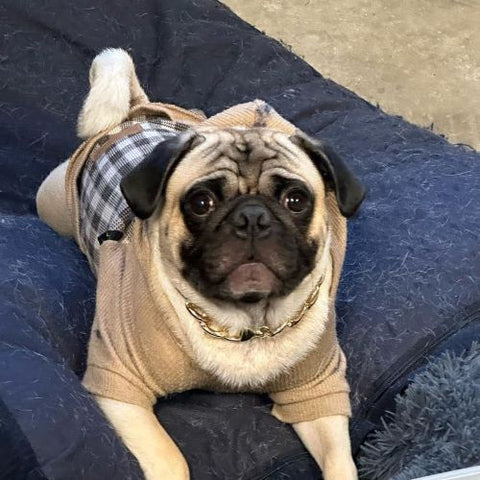
Socialize Your Puppy:
- Expose your Pug puppy to various people, animals, and environments during their critical socialization period (8-16 weeks)
- Introduce new experiences gradually and positively, pairing them with treats and praise
- Attend puppy classes or organize playdates with other puppies to help your Pug learn proper social skills
Important Socialization Tips:
- Ensure all interactions are positive and non-threatening
- Allow your puppy to approach new people and animals at their own pace
- Watch for signs of fear or anxiety, and give your puppy breaks if needed
- Provide plenty of praise and treats for confident, friendly behavior

Leash training and socialization are ongoing processes that require patience and consistency. Take things at your Pug puppy's pace, and always prioritize their comfort and safety. By dedicating time to these essential training aspects, you'll help your Pug puppy grow into a well-behaved and well-adjusted adult dog.
6. How to Deal with Common Pug Puppy Behavioral Issues
As your Pug puppy grows and develops, you may encounter some common behavioral issues. Here's how you can address them:
Excessive Barking:
- Identify the trigger for the barking (e.g., boredom, attention-seeking, or fear)
- Teach your puppy the "quiet" command, rewarding them for being silent
- Provide plenty of mental stimulation and exercise to prevent boredom-related barking

Chewing and Destructive Behavior:
- Puppy-proof your home by removing or securing items you don't want your puppy to chew
- Provide a variety of appropriate chew toys to redirect your puppy's chewing instincts
- Supervise your puppy closely, and if you catch them chewing something inappropriate, redirect them to a proper chew toy
Separation Anxiety:
- Help your puppy learn to be comfortable alone by gradually increasing the duration of separation
- Create a positive association with being alone by providing a special toy or treat when you leave
- Avoid making a big fuss when coming and going, as this can increase your puppy's anxiety
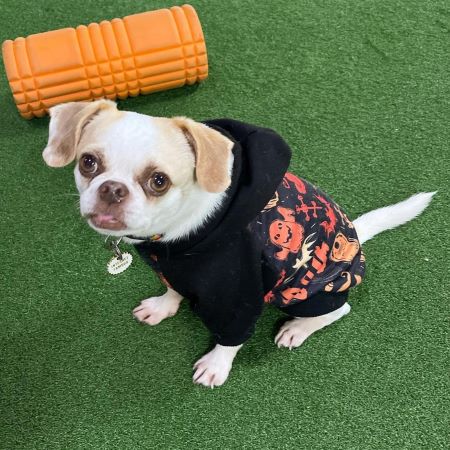
Jumping on People:
- Ignore your puppy when they jump, turning away and withholding attention
- Reward your puppy with praise and treats when they keep all four paws on the ground
- Teach your puppy an alternative behavior, like sitting, to greet people politely
Consistency and positive reinforcement are key when dealing with behavioral issues. Reward your Pug puppy for good behavior, and redirect them calmly when they make mistakes. If you're struggling to resolve a particular issue, don't hesitate to seek guidance from a professional dog trainer or behaviorist.
7. What Are Some Pug-Specific Training Tips?
When training your Pug puppy, it's important to keep their unique characteristics and needs in mind. Here are some Pug-specific training tips:
Manage Respiratory Issues:
- Be mindful of your Pug's breathing during training sessions, especially in hot or humid weather
- Take breaks if your puppy starts to wheeze, snort, or struggle to breathe
- Avoid using a collar that puts pressure on your Pug's neck, as this can exacerbate respiratory issues

Keep Training Sessions Cool and Comfortable:
- Train your Pug puppy in a cool, air-conditioned space during hot weather
- Avoid exercising your puppy outdoors during the hottest parts of the day
- Always provide access to fresh, cool water during training sessions
Avoid Overexertion:
- Pugs are a low-energy breed, so keep training sessions short and low-intensity
- Break up training into several short sessions throughout the day
- Monitor your puppy for signs of fatigue, such as excessive panting or lying down, and take breaks as needed
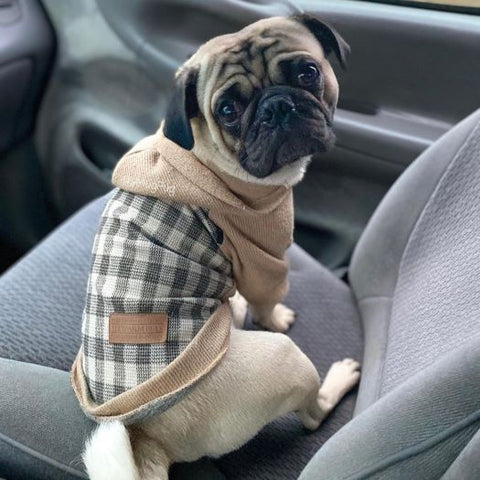
Tailor Training to Your Pug's Physical Limitations:
- Pugs' short legs and stocky build can make certain activities, like jumping or climbing stairs, challenging
- Modify training exercises to suit your Pug's physical abilities
- Use ramps or steps to help your puppy access furniture or navigate stairs safely
By keeping these Pug-specific tips in mind, you can ensure that your training sessions are safe, comfortable, and effective for your wrinkly little companion. Remember, every puppy is unique, so be patient and adjust your training approach as needed to best suit your individual Pug.
Embrace the Journey: Raising a Well-Trained and Loving Pug Puppy
Training your Pug puppy is an exciting and rewarding adventure that will strengthen your bond and create a lifetime of cherished memories. By staying patient, consistent, and loving, you'll help your wrinkly little companion blossom into a well-behaved and confident dog. Remember to celebrate the small victories, keep training sessions fun, and never stop learning and growing together. With your dedication and guidance, you'll discover the incredible joy of raising a happy, healthy, and utterly adorable Pug puppy. So, embrace the journey, cherish every moment, and get ready to experience the unconditional love and loyalty that only a well-trained Pug can offer.
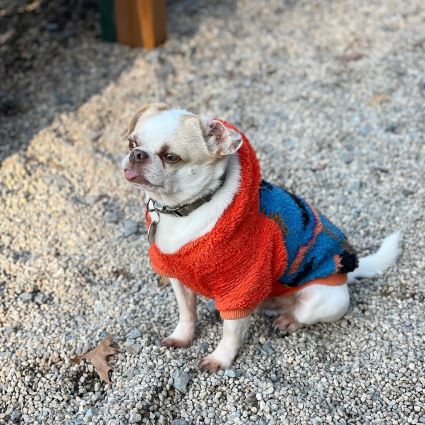
Frequently Asked Questions (FAQs)
Q1: At what age should I start training my Pug puppy?
A: You can begin basic training as soon as you bring your Pug puppy home, usually around 8 weeks old. Start with simple commands like "sit" and "come," and focus on socialization and house training. Keep sessions short and positive, as puppies have short attention spans.
Q2:How often should I train my Pug puppy?
A: Aim for several short training sessions throughout the day, lasting about 5-10 minutes each. Consistency is key, so try to incorporate training into your daily routine, such as before meals or during playtime.

Q3: How do I stop my Pug puppy from biting during play?
A: Puppy biting is a normal part of development, but it's important to teach your Pug that it's not acceptable. When your puppy bites, yelp loudly and stop playing. Offer a chew toy instead, and praise them for biting the toy. Consistently redirecting biting behavior will help your puppy learn proper play manners.
Q4: Are Pugs easy to potty train?
A: Pugs can be a bit stubborn when it comes to potty training, but with patience and consistency, most Pugs can be successfully trained. Stick to a regular potty schedule, use positive reinforcement, and supervise your puppy closely to prevent accidents.
Q5: Can I train my Pug puppy to get along with my cat?
A: Yes, with proper socialization and supervision, Pugs can learn to coexist peacefully with cats. Introduce them slowly and calmly, rewarding positive interactions and separating them if either animal becomes too excited or aggressive. Consistent positive reinforcement will help your Pug puppy learn to respect and enjoy your cat's company.




